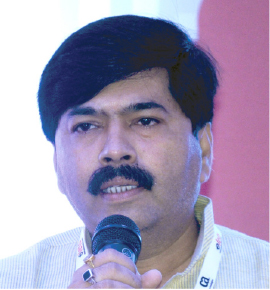
Wooing entrepreneurs to invest in MP
The job of the Department of Industries is to facilitate the investment in Madhya Pradesh through development of industrial areas and by providing incentives to the industrial units. We also handle a self-employment scheme, called Mukhyamantri Swarojgar Yojna (Chief Minister’s Employment Scheme) and Mukhyamantri Yuva Udyami Yojna (Chief Minister’s Young Entrepreneur Scheme), where we target about 20-25,000 young entrepreneurs and give them loans through banks with considerable subsidy and support. Apart from the Urban Development Department and Municipal Corporation, Smart Cities also involve industrial units and entrepreneurs. Transformation of a city into a smart one requires a lot of investment, sourcing and supply of material, which is possible through entrepreneurs. It will provide opportunities for entrepreneurs to set up their establishments. Another aspect is development of smart industrial area for entrepreneurs; we should ensure that the citizens of industrial area get smart amenities. Further, we want entrepreneurs to come from abroad and invest in MP.
Ensuring hawkers’ livelihood in Smart Cities

The Government of Madhya Pradesh has unveiled two schemes to reduce unemployment and generate huge job opportunities. Mukhyamantri Swarojgar Yojna and Mukhyamantri Yuva Udyami Yojna provide loan up to `10 lakh and `1 crore, respectively. Municipal Corporations also offer loans, ranging from `10,000 to `20 lakh to street vendors and hawkers. So, we should spare a thought to vegetable sellers and hawkers and try to make a hawker’s zone in the proposed Smart Cities, ensuring their livelihood. In addition, there will be proper parking lots in vending zones. Industrialisation shouldn’t hamper the development of a city. As far as ‘Make in India’ is concerned, ULBs can play a major role. The civic bodies must ensure basic amenities in the city areas and its outskirts. The Corporations should help eradicate unemployment and settle the hawkers from a congested place to a particular zone. Also, the hawkers’ zones should be developed in such a way that people should have adequate parking space.

NITEEN YEOLA
Second Secretary-Designate, High Commissioner of India, Colombo, Ministry of External Affairs
India emerging as an investment destination

The Union Government is making a lot of concerted efforts to promote India as an investment destination globally, and there are a plethora of success stories. We need to understand the domestic as well as investors’ perception. The ‘Make in India’ campaign has significantly changed the perception of people about our country and now other countries are looking at us much more positively than earlier. In ‘Make in India’ and ‘Make in MP’, a lot of emphasis has been laid on attracting investment but at the same time, we should also think of responsibilities of investors and industries. There has to be a symbiotic relationship between the regulation and the industry. If we have to make the campaign successful, we have to strike a balance between the environment and industry. The credibility would depend upon how effectively regulations and legislations are being implemented. In the context of ‘Ease of doing business in India’, a lot of things have been changed at the ground level. Parallel processing, single window clearance and making things online have taken place. So, we need to have a targeted approach and an attitudinal shift is also required.
Ready to host ‘Simhastha’
‘Simhastha’ is a Maha Kumbh, which is attended by around five crore people in a small duration of one month in Ujjain, Madhya Pradesh. Every year, this 30 day-long event starts on April 22 and continues till May 21. So, we have attempted that the entire planning of ‘Simhastha’ is done on the GIS map. All the plots allotted to sadhus are visible on the GIS map comprising 42 different layers. Combined with the GIS planning, we have developed a software called ‘Plots’ that enables various departments to access all information on the allotment of plots and amenities like toilets, water taps and sewerage. It also helps immensely in executing the projects. The entire Kumbh area has been divided into six zones— each zone further divided into sectors and all planning has been taken up accordingly. For public transport, entire road planning is being done on the GIS. We also ensure that all the plots must not have service roads so as to prevent the congestion of people’s movement during the Kumbh.
Be a part of Elets Collaborative Initiatives. Join Us for Upcoming Events and explore business opportunities. Like us on Facebook , connect with us on LinkedIn and follow us on Twitter, Instagram.













